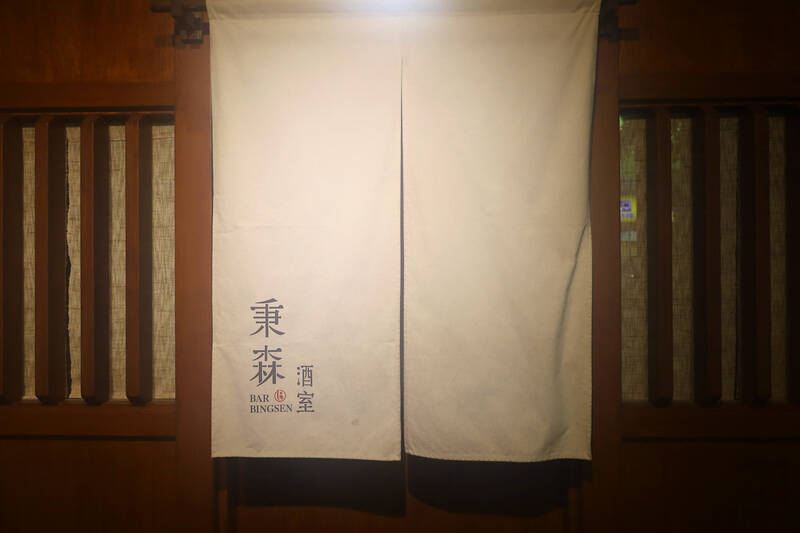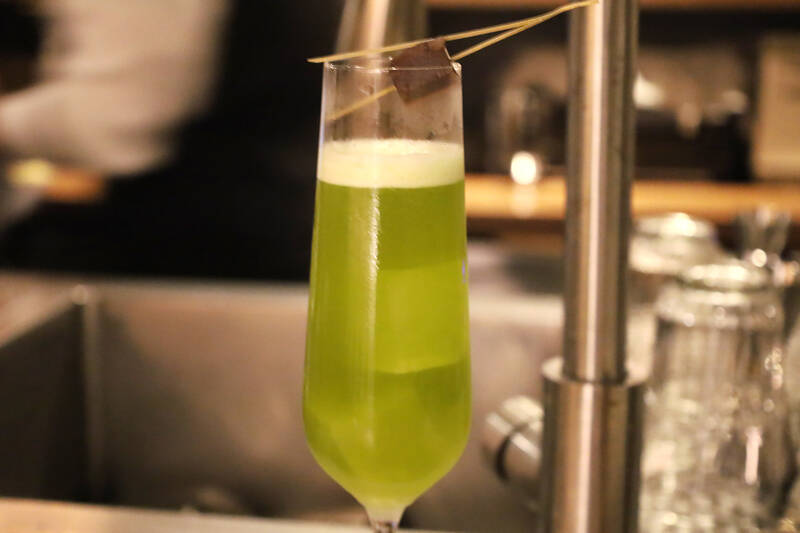Sunset in subtropical Chiayi (嘉義) is as many-hued as the local palate. The afternoon rain on the streets reflect the sky as it turns pink and purple. As the city’s neon lights flare into life, everywhere, it seems, signposts dinner.
Evening commences along the half-a-kilometer long night market on Wenhua Road (文化路). This strip featured in the Netflix series Street Food Asia.
There are fish-head noodle stalls and grapefruit bubble tea vendors, onion pancake and squids-on-sticks, Vietnamese sandwiches, tofu and sizzling pork skewers.

Photo Thomas Bird, Taipei Times
The heady scent of barbequing king oyster mushrooms catches my attention. After a fungi-licious appetizer, I sit down for a main course — cold noodles, Chiayi-style — with cucumbers, beansprouts, sesame seed paste and special ingredient, mayonnaise.
“That’s how we do it here, it holds the noodles together,” the vendor says.
FIRST PORT OF CALL

Photo Thomas Bird, Taipei Times
With my stomach lined, it’s a short hike to the end of Wenhua Road, where, at the crossroads of the Alishan mountain railway, I aim for Calgary (卡加利美式餐廳), which was recommended to me by an old-Chiayi-hand as “a pub with a railway flavor.”
The bar manager tells me Calgary has been in business since the late-1990s although the building itself, where “Timber was brought from the mountains to be chopped and turned into furniture,” is far older.
Logging officially ended in 1988 but much of city’s sites still allude to Chiayi’s former life as Taiwan’s “city of timber” and the railroad culture that kept that resource economy rolling.

Photo Thomas Bird, Taipei Times
Calgary’s vintage address is redolent of old Chiayi, but it is otherwise the kind of watering hole you might find in any small city in Asia — a place where barflies prop up the bar and put the world to right over pints of Carlsberg (NT$220) and Hawaiian Pizza (NT$360) until the weekend band kicks in. Notwithstanding its “last chance coral” vibes, I like Calgary, which boasts many of the “elements of a great bar” Anthony Bourdain once listed in A Cook’s Tour, notably convivial staff ever eager to top up your glass.
COCKTAILS AND FOOD PANDA
Walking through the curtains into Bar Bingsen (秉森酒室) is like stepping into a wormhole leading directly to Shinjuku, Tokyo. This perfect imitation of an izakaya is only a five-minute walk along the railway from Calgary but it feels a world apart.

Photo Thomas Bird, Taipei Times
Despite its imitative pretentions, there are no suited company men bonding over whisky and cigarettes as you might find in Japan. Instead, Bingsen is the habitat of hip Chiayi locals sipping Instagramable cocktails while ordering snacks from their phones via the Food Panda app.
“You can order outside food but you must buy drinks here,” the barman says of the house rules.
I’m well-fed but getting watered won’t be quite so economical, I soon discover, while eying the drinks list with average drink prices between NT$300 to NT$400.

Photo Thomas Bird, Taipei Times
Still, what is cool about Bar Bingsen is the range of locally-inspired concoctions — cocktails with poetic names like Sea of Flowers Amidst the Bustle (NT$420), a sumptuous gin-based beverage infused with cherry blossom and camphorwood and Town With and Ocean View (NT$360) made with vodka, buckwheat, elderflower and honey.
Equal attention has been given to the service — from the debonair attire of the barmen to the immaculate open bar, where they mix beverages to a jazz soundtrack.
Yet while Bingsen’s young clientele seem satisfied fetishizing colorful drinks, the place is bit stiff for a laidback southern town.

Photo Thomas Bird, Taipei Times
TIKI IN CHIAYI
Following the directions of a Bingsen regular, I pass Chiayi Railway Station’s forecourt and facing the Chiayi Art Museum find HOT Hi-End Of Tiki.
The exterior is adorned with collage of wild tropical animals, the interior decorated like a classic American cocktail lounge.
“I learned to be a mixologist in Taipei but wanted to bring this culture back to my hometown,” says Wang Wei-chi (王湋際), who opened the bar in 2021.
Wang survived coronavirus-enforced restrictions and now employs two local students to help him cater to a regular cast of patrons.
“Old people don’t get it but young people like what we do here.”
I order a Seasonal G&T (NT$300) — a predictable tipple for a Brit in the subtropics — but Wang mixes it in an atypical way, with a liqueur that he makes with four different kinds of fruit.
I repeat what the barman at Bingsen had told me, that cocktail bars were mushrooming in Chiayi, because it’s “a fresh market” that’s “not been saturated like elsewhere.”
Wang agrees, although he notes low rent when compared with Taipei keeps overheads down, which, combined with a flow of tourists bound for Alishan, makes opening a cocktail bar in Chiayi a more sensible idea than it might first appear.
I conclude with a Jungle Smack (NT$300), a delicious, banana-flavored bourbon with bitters, then stumble off to my hotel.
En route, I think about Street Food Asia and TV chef Johanna Liu’s (劉韋彤) assertion that, “Because of the secluded location, Chiayi has not been very influenced by foreign culture.”
As one of Taiwan’s oldest settlements, Chiayi unquestionably maintains some fine Taiwanese traditions. But it’s also seen some history. From the eclecticism of night market through to its varied night haunts, I’ve tasted a myriad influences in my short tour.
Sure, Chiayi might be small, but provincial it is not.
Warning: Excessive consumption of alcohol can damage your health.

The Democratic Progressive Party (DPP), Chinese Nationalist Party (KMT), and the country’s other political groups dare not offend religious groups, says Chen Lih-ming (陳立民), founder of the Taiwan Anti-Religion Alliance (台灣反宗教者聯盟). “It’s the same in other democracies, of course, but because political struggles in Taiwan are extraordinarily fierce, you’ll see candidates visiting several temples each day ahead of elections. That adds impetus to religion here,” says the retired college lecturer. In Japan’s most recent election, the Liberal Democratic Party lost many votes because of its ties to the Unification Church (“the Moonies”). Chen contrasts the progress made by anti-religion movements in

Taiwan doesn’t have a lot of railways, but its network has plenty of history. The government-owned entity that last year became the Taiwan Railway Corp (TRC) has been operating trains since 1891. During the 1895-1945 period of Japanese rule, the colonial government made huge investments in rail infrastructure. The northern port city of Keelung was connected to Kaohsiung in the south. New lines appeared in Pingtung, Yilan and the Hualien-Taitung region. Railway enthusiasts exploring Taiwan will find plenty to amuse themselves. Taipei will soon gain its second rail-themed museum. Elsewhere there’s a number of endearing branch lines and rolling-stock collections, some

Last week the State Department made several small changes to its Web information on Taiwan. First, it removed a statement saying that the US “does not support Taiwan independence.” The current statement now reads: “We oppose any unilateral changes to the status quo from either side. We expect cross-strait differences to be resolved by peaceful means, free from coercion, in a manner acceptable to the people on both sides of the Strait.” In 2022 the administration of Joe Biden also removed that verbiage, but after a month of pressure from the People’s Republic of China (PRC), reinstated it. The American

This was not supposed to be an election year. The local media is billing it as the “2025 great recall era” (2025大罷免時代) or the “2025 great recall wave” (2025大罷免潮), with many now just shortening it to “great recall.” As of this writing the number of campaigns that have submitted the requisite one percent of eligible voters signatures in legislative districts is 51 — 35 targeting Chinese Nationalist Party (KMT) caucus lawmakers and 16 targeting Democratic Progressive Party (DPP) lawmakers. The pan-green side has more as they started earlier. Many recall campaigns are billing themselves as “Winter Bluebirds” after the “Bluebird Action”